Every year as my bass tournament season comes to an end, I start thinking about crappie fishing. I like to take a break and let the competitive flames refuel a bit. When the calendar strikes November and water temperatures dip into the 50s in Tennessee, I take several days to go crappie fishing. These fish make really good table fare, they are also very fun to catch, especially the big ones like you find in winter.
I am well aware of how good crappie fishing is in spring. But for the way I fish for them around home, fall and winter are when you can really fill the livewell. Crappie stack up in large schools this time of year, at it’s not hard to catch them if you know what to look for.
Crappie always hang around cover of some type. The two key pieces of structure on my home water are boat docks and laydowns. There are a few docks that seem to always hold fish, but I like to hunt for them with my Raymarine electronics. I turn on SideVision mode and start searching. Crappie will be in big schools, and I might go down a line of 50 docks with only one dock holding the mother lode. To see how big they are and to make sure they are crappie, I will put an Aqua Vu camera down there and check them out.
Most of the docks I fish are floating, and the magical depth is normally at least 20 feet of water under the dock. The crappie will normally be suspended under these docks anywhere from 8 to 15 feet down, depending on the water clarity.
It works the same way when fishing laydowns. I look for laydowns on vertical banks that have a good-sized trunk. If they have a big trunk, I know there is a good-sized treetop out in the water. If they are there, I will see them on my SideVision.
Once you find fish, cast exactly where they are or just beyond them, not 3 feet to the left or right. If you miss a crappie’s strike zone by 6 inches, you’ve missed it by a mile. Make the cast, count your bait down to the desired depth and reel just fast enough to maintain that depth. No jigging, nothing fancy, just a slow reel.
My favorite jig head is a 1/32-ounce ball-shaped jig head with a good sharp Mustad hook, but I will go up to a 1/16-ounce if the wind is blowing or I’m fishing deeper than normal. Any soft plastic minnow imitation in the 2-inch range with a straight tail will work. Stay away from twist-tail grubs for this method because they cause your bait to rise too much. I use a S721 MHX rod built with supplies from Mud Hole Custom Tackle, including a Winn grip. It is 6-foot-long, super-sensitive and has the perfect action for controlling small baits. I team it with a 1000-size spinning reel and 4-pound Vicious Panfish line in fluorescent green. The green line helps me detect light strikes.
These tips will help you all the way up until crappie start moving shallow to spawn. These fish are fat and healthy this time of year. So get out and have some fun this winter.
